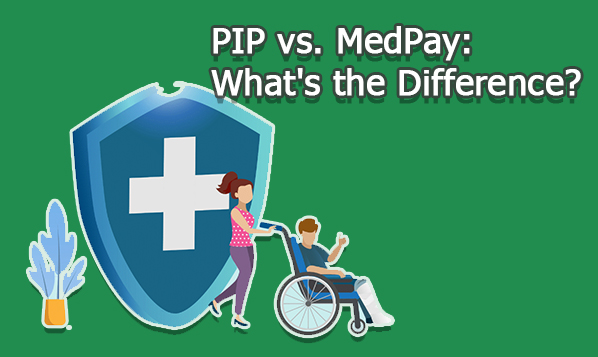PIP vs. MedPay: What’s the Difference – if you reside in a “no-fault” state, you must obtain either Medical Payments (MedPay) or Personal Injury Protection (PIP). In the event of an accident, no-fault insurance policies that pay for injuries to you and your passengers include personal injury protection (PIP) and medical payments (MedPay).

The coverage begins when an accident occurs, no matter who is at fault. Legal requirements for one or both of these coverage exist in no-fault states (as well as in a few tort states), and they are optional in other states. Although there are certain similarities between PIP and MedPay, it’s important to be aware of the differences as well.
PIP vs. MedPay: What’s the Difference
No matter who is at fault, PIP and MedPay both cover damage to you as the motorist and anyone else in your vehicle in an accident. The coverage of medical costs resulting from accidents is different from other areas.
What Is Personal Injury Protection (PIP)
Personal injury protection (PIP) is an insurance policy that covers the medical expenses incurred in an accident, regardless of the individual’s fault. It is normally supplied by your auto insurance provider, and if the driver has PIP coverage, it might also cover you as a passenger. Generally, PIP coverage has a maximum amount per person. However, if your medical bills surpass this amount, your health insurance might pay the balance. Not all states have laws requiring PIP coverage.
Advantages and Disadvantages of Personal Injury Protection (PIP)
Many people find personal injury coverage appealing, particularly if they are not eligible for state or employer-sponsored health insurance.
Among the advantages of PIP coverage are:
- Coverage for hospital costs, irrespective of health insurance status.
- Minimum coverage limits that are adjusted according to your injuries.
- Coverage right away as opposed to waiting for payment.
- A portion of funeral costs, death benefits, and lost income are covered.
However, since each state has its own set of regulations and restrictions, access to PIP coverage varies. Among the disadvantages are:
- After filing PIP claims, insurance premium increases may result in monthly increases of $100 or more.
- Redundant coverage if your health insurance provides the same advantages already.
- Higher rates for auto insurance in states where PIP coverage is required.
- Ohio does not offer PIP coverage.
If your health insurance covers the same things as PIP, you should file your claims through your health insurance company. Health insurance premiums usually don’t increase following a claim, in contrast to PIP.
What is MedPay
MedPay, or Medical Payments Coverage, is an add-on to auto insurance policies that cover medical expenses incurred in an accident, regardless of the party at fault. PIP and MedPay share some similarities, but it’s crucial to understand the main differences between the two coverages and MedPay coverage.
MedPay offers coverage for important and applicable medical costs for insured individuals to cover after an automobile accident, regardless of the cause. For people who require additional financial security to cover their medical costs following an accident, this coverage may be advantageous. However, because of its more constrained coverage, MedPay might not be able to adequately replace PIP.
Advantages and Disadvantages of MedPay
MedPay is a supplement to traditional liability insurance, used by some drivers to enhance their PIP regulations. Despite the restricted coverage, MedPay offers a few benefits that make it worthwhile to take into account:
- In a tort state, individuals are responsible for their medical expenses if they are at fault.
- You might need to take legal action to get your losses compensated if the other driver is at fault. This can take months or even years in court.
- MedPay differs from most health insurance plans in that it has no co-pay or deductible.
- If you are hurt while riding a bike or walking, walking, or taking public transportation, you are covered.
- You are also covered if you are hurt as a passenger in another vehicle.
However, MedPay has certain disadvantages, including:
- No reimbursement for funeral expenses or partially missed income.
- Not available in some states.
- Restricted coverage against drivers and passengers who are not members of your direct family.
- Increases in premiums, but not as much as with PIP insurance.
Cost of PIP vs. MedPay
MedPay is a low-cost payment method with a maximum payout of $5,000 to $10,000, with an additional fee of $5 per month. However, the price of your PIP coverage will differ significantly based on the state in which you reside. When you consider the full range of required coverage that you must have, this makes a lot of sense.
The maximum amount per accident will be $2,500, and the maximum for medical expenses and permanent injury benefits will be $250,000. PIP is only one component of the required coverage in no-fault states, so calculating its cost is difficult.
However, it is feasible to contrast the mean expense in tort and no-fault states. Furthermore, states like Oregon, Pennsylvania, Texas, Utah, North Dakota, Florida, Michigan, Delaware, Hawaii, Kansas, Kentucky, Massachusetts, Minnesota, New Jersey, New York, and North Dakota have PIP requirements. There are various minimum requirements for PIP coverage in each state.
PIP vs. MedPay: What’s the Difference
Selecting the best auto insurance coverage for your needs requires understanding the differences between Medical Payments Coverage (MedPay) and Personal Injury Protection (PIP). Med Pay covers emergency room and ambulance fees in the event of a car accident, while PIP also pays for other costs and lost wages. In contrast to Med Pay, PIP also covers professional health services, psychiatric costs, and physical and occupational therapy.

